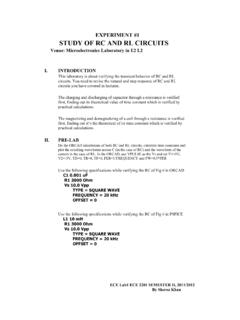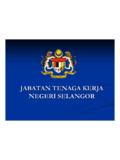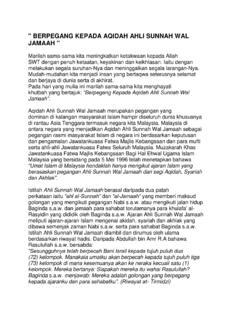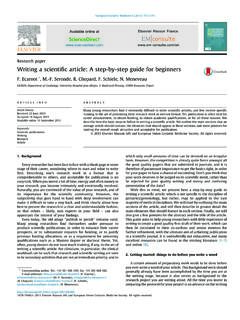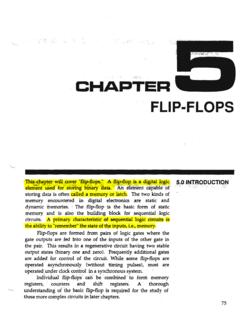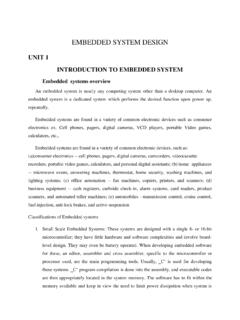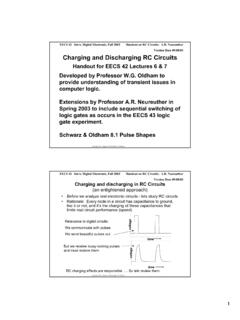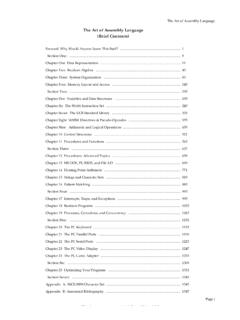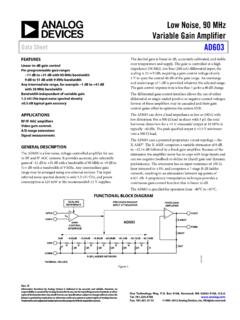Transcription of Experiment Sequential Circuits 6 PART A: FLIP FLOPS
1 1 | P a g e Experiment 6 Sequential Circuits Objective -To become familiar with the input/output characteristics of several types of standard flip-flop devices and the conversion among them. References Donald : Experimental in Digital Principles, 3rd Edition Malvino/Leach : Digital Principles and Applications Bartee : Digital Computer Fundamentals, 6th Edition John : Digital Designs , Principle and Practice, 2nd Edition Ronald A Reis: Digital Electronics Through Project Analysis, 1st Edition Component 1-74LS00 TTL IC 1-74LS74 TTL IC 1-74LS76 TTL IC Introduction Logic circuit whose outputs depend upon circuit inputs as well as previous values of circuit outputs described as their present states are known as Sequential logic Circuits . A Sequential system can be defined in terms of its inputs and present state.
2 That is, the next state of the Sequential system can be determined from these two quantities. The (clocked) RS, D, JK and T flip- FLOPS are characterized by the following state tables. PART A: FLIP FLOPS 2 | P a g e The ? in the RS flip-flop state table (refer to table 1) means that when R = 1 and S = 1 then the next state is not determined explicitly. Procedure 1) Construct the cross-coupled NAND gate basic RS flip-flop depicted in fig and verify its Sequential operation by completing the timing diagram shown in fig Fig : Basic RS flip flop 3 | P a g e R t S t Q t Q t Fig : Timing Diagram 2) Construct the clocked RS flip flop of fig 3. Complete timing diagram as in fig but add clock pulses as extra input. Use pulse switch as your clock source.
3 Fig : Clocked RS flip-flop 3) Simultaneously application of ones to R and S of the clocked RS flip flop, observe the outputs. 4) Since the constructed clocked RS flip flop is symmetric, we can change the position of R & S, and Q and Q . It is still a clocked RS flip flop. Repeat step 3, see what has happened. Give your conclusion. 4 | P a g e 5) Using the 74LS74 dual D flip flop, investigate the operation of the D flip-flop (see fig ). Compare your result with the state table given above. Pay attention to the change in state of the device as the clock signal is rising or falling. Compare the following timing diagram. Fig : D Flip Flop Assume when t=0 , Q=0 CLK t D t Q t Fig : Timing Diagram 6) Let input R open, ground the input S, watch the output and then let S open, ground R, watch the output.
4 Determine the usage of R and S. 5 | P a g e 7) Using the 74LS76 dual JK flip flop, determine its logical operation. The circuit diagram is shown in fig . Pay attention to the change in state of the device as the clock signal is rising or falling. Compare the following timing diagram. Fig : JK Flip flop assume when t=0 , y=0 CLK t K t J t Y t Fig : Timing diagram 6 | P a g e 8) The flip flop can simulate each other. Construct the circuit shown in fig Verify its Sequential operation as a D flip flop. Complete the following timing diagram. Compare it with the timing diagram of fig Fig : D flip flop ( constructed by JK FF) assume when t=0 , Q=0 CLK t D t Q t Fig : Timing Diagram 7 | P a g e 9) Wire the circuit shown in fig , verify that it is a T flip flop by.
5 Drawing the timing diagram for the T flip flop. Fig : T flip flop 8 | P a g e Objectives -To design a ripple counter using JK flip flop. -To connect a pre-settable counter and observe its operation. -To create different counter module by decoding outputs and loading preset inputs. Introduction A counter is a circuit consisting of a number of Flip Flop and gates working together to count the number of clock pulses applied to its input. Such counters are used in digital clocks, frequency counters, digital voltmeters, digital computers, and numerous other applications. There are numerous types of counters, and we cannot look at theme in this Experiment . The basic binary counter is probably the simplest to construct and form the basis for more advanced types of counters.
6 In this Experiment , we look at some of the counter Circuits found most often and give you an opportunity to connect and observe them. Ripple Counter(Asynchronous) A ripple counter is a serial counter. The clock input is applied to only the first of the series of the Flip Flop. Clock pulses for the other Flip Flop come from the preceding Flip , the clock pulse ripple through the circuit in a series fashion. Such circuit is also called asynchronous since the only pulse required for the operation is the clock pulse. The JK Flip Flop have the J and K inputs both tied high, which allows them to toggle with each input pulse. Fig 7-1 shows a 4-bit ripple counter. PART B: COUNTERS Sequential Circuits Experiment 6 9 | P a g e Fig. : Logic diagram for a 4-bit (mod16) ripple counter.
7 Synchronous Counters The synchronous counter has the limitation of the time lag in triggering all the Flip Flop. To cure this problem, parallel counters can be used. The logic diagram for a 3-bit parallel counter is shown in fig 7-2. Note that all CLK inputs are tied directly to input clock. They are wired in parallel. Note that also the use of the AND gate at the output of Flip Flop 2 which will either hold Flip Flop 3(AND=0), or toggle Flip Flop 3(AND=1). Fig 10 | P a g e UP DOWN IC Counter : The 74193 The 74193 is a synchronous up-down 4-bit binary counter. It has a master reset (CLR), and it can be reset to any desired count with the parallel load inputs. Basically, it functions like any binary counter, except that is has two clock inputs, one for UP counting , and the other for DOWN counting.
8 The logic symbol for the 74193 is shown in fig 7-3 (examine the data sheet).LOAD is a control input to load data into pins A, B,C and D. Figure Pin CLR is the master reset, and it is normally held below (a high level on CLR will reset all FF). CO and BO are outputs to be used to drive the following 74193 s and we shall simply leave them open. The clock inputs are UP and DOWN. Placing the clock on UP will cause the counter to count UP, and placing the clock on DOWN will cause the counter to count DOWN. Note that the clock should be connected to either UP or DOWN, but not both, and the unused inputs should be held HIGH. The outputs of the counter are QA,QB,QC and QD . Components needed: 1-74LS00 Quad NAND Gate TTL IC 2-74LS76 Dual JK Flip Flop 1-74LS93 4 bit binary counter 1-74LS193 4 bit UP-DOWN counter 1- Oscilloscope 11 | P a g e Procedure 1) Construct the Ripple counter shown in fig Clear all output FF by giving a negative clock pulses to the clear inputs, and apply the clock of a one shot actuated by the push button.
9 Repeat that for 17 clock pulses. Record the output QA,QB,QC and QD of the counter in table 1 below (MSB = QD ; LSB = QA ) Draw the timing diagram of the above circuit . Table 1 2) Use the 74LS93 counter to implement a) A modulo 16 counter; b) A decade counter 3) Make these connections to the counter of fig Pin 15,1,10 and 9 (preset data inputs ) Open Pins 12 and 13 (CO and BO)Open Pins 3,2,6 and 7 (outputs ) to LED s Pin 11 (LOAD) to +Vcc Pin 16 (+Vcc) to +Vcc Pin 14 (CLR) to ground Pin 8 (GND) to ground CLK Pulse QC QD QB QA 1 2 3 4 5 6 7 8 9 CLK Pulse QD QC QB QA 10 11 12 13 14 15 16 17 18 12 | P a g e 4) For the count-up mode, connect pin 4 (DOWN) to +Vcc, and apply the clock to pin 5(UP).
10 Record carefully the 4 output waveforms with respect to the clock. 5) For the count-down mode, connect pin 5(UP) to +Vcc , and apply the clock to pin 4(DOWN). Record the resulting output waveforms. 13 | P a g e About registers A flip-flop is a Sequential device able to store one binary bit of information. More general Sequential device, constructed by interconnecting a number of flip FLOPS , can process one or more bits of information and are known as REGISTERS and COUNTERS. A REGISTER is a memory device used for storing and manipulating data registers (found by the thousand in digital computers)may be classified according to how their stored information is entered or removed. A SERIAL register is one in which the data is entered or removed one bit at a time and a PARALLEL register accepts or transfers all bits of data simultaneously.
